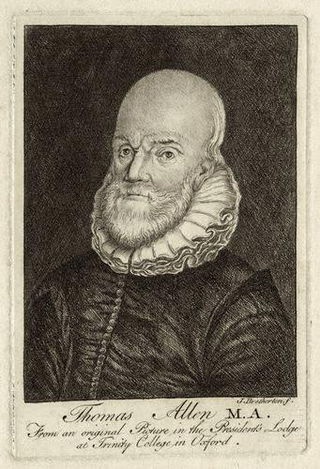
Philippa of Clarence was a medieval English princess and the suo jure Countess of Ulster.

The Keeper or Master of the Rolls and Records of the Chancery of England, known as the Master of the Rolls, is the President of the Civil Division of the Court of Appeal of England and Wales and Head of Civil Justice. As a judge, the Master of the Rolls is second in seniority in England and Wales only to the Lord Chief Justice. The position dates from at least 1286, although it is believed that the office probably existed earlier than that.

The Rye House Plot of 1683 was a plan to assassinate King Charles II of England and his brother James, Duke of York. The royal party went from Westminster to Newmarket to see horse races and were expected to make the return journey on 1 April 1683, but because there was a major fire in Newmarket on 22 March, the races were cancelled, and the King and the Duke returned to London early. As a result, the planned attack never took place.
The title of Earl of Gloucester was created several times in the Peerage of England. A fictional earl is also a character in William Shakespeare's play King Lear.

Thomas Allen was an English mathematician and astrologer. Highly reputed in his lifetime, he published little, but was an active private teacher of mathematics. He was also well connected in the English intellectual networks of the period.
Ealdgyth, also Aldgyth or Edith in modern English, was a daughter of Ælfgar, Earl of Mercia, the wife of Gruffudd ap Llywelyn, ruler of all Wales, and later the wife and queen consort of Harold Godwinson, king of England in 1066. She was described by William of Jumièges as a considerable beauty.

Justice of the Common Pleas was a puisne judicial position within the Court of Common Pleas of England and Wales, under the Chief Justice. The Common Pleas was the primary court of common law within England and Wales, dealing with "common" pleas. It was created out of the common law jurisdiction of the Exchequer of Pleas, with splits forming during the 1190s and the division becoming formal by the beginning of the 13th century. The court became a key part of the Westminster courts, along with the Exchequer of Pleas and the Court of King's Bench, but with the Writ of Quominus and the Statute of Westminster, both tried to extend their jurisdiction into the realm of common pleas. As a result, the courts jockeyed for power. In 1828 Henry Brougham, a Member of Parliament, complained in Parliament that as long as there were three courts unevenness was inevitable, saying that "It is not in the power of the courts, even if all were monopolies and other restrictions done away, to distribute business equally, as long as suitors are left free to choose their own tribunal", and that there would always be a favourite court, which would therefore attract the best lawyers and judges and entrench its position. The outcome was the Supreme Court of Judicature Act 1873, under which all the central courts were made part of a single Supreme Court of Judicature. Eventually the government created a High Court of Justice under Lord Coleridge by an Order in Council of 16 December 1880. At this point, the Common Pleas formally ceased to exist.
During the early part of the 17th century, and persisting in some form into the early 18th century, there were a number of proposals for an English Academy: some form of learned institution, conceived as having royal backing and a leading role in the intellectual life of the nation. Definite calls for an English Academy came in 1617, based on the Italian model dating back to the 16th century; they were followed up later, after the 1635 founding of the French Académie, by John Dryden (1664), John Evelyn (1665), and Daniel Defoe (1697).
Essex Street Chapel, also known as Essex Church, is a Unitarian place of worship in London. It was the first church in England set up with this doctrine, and was established when Dissenters still faced legal threat. As the birthplace of British Unitarianism, Essex Street has particularly been associated with social reformers and theologians. The congregation moved west in the 19th century, allowing the building to be turned into the headquarters for the British and Foreign Unitarian Association and the Sunday School Association. These evolved into the General Assembly of Unitarian and Free Christian Churches, the umbrella organisation for British Unitarianism, which is still based on the same site, in an office building called Essex Hall. This article deals with the buildings, the history, and the current church, based in Kensington.

The Octagon Chapel, Liverpool, was a nonconformist church in Liverpool, England, opened in 1763. It was founded by local congregations, those of Benn's Garden and Kaye Street chapels. The aim was to use a non-sectarian liturgy; Thomas Bentley was a major figure in founding the chapel, and had a hand in the liturgy.
Events from the year 1579 in the Kingdom of Scotland.

Twickenham Park was an estate in Twickenham in south-west London.

Beaufort Street is a street in Chelsea, London SW3. It runs north to south from Fulham Road to Cheyne Walk, and is bisected by the King's Road.
Henry Coventry was an English religious writer.
Ann Smith was an English anti-Catholic political activist. A devout Baptist, she and her family sheltered the rebel 9th Earl of Argyll when he was in hiding in London and fled with him to the Spanish Netherlands in 1683. She lived with her husband in Utrecht and following his death funded Argyll's Rising in Scotland and the contemporaneous Monmouth Rebellion in England. She hosted fellow conspirator Elizabeth Gaunt in Amsterdam and received a royal pardon for her activism in 1686, after which time records of her life cease.









